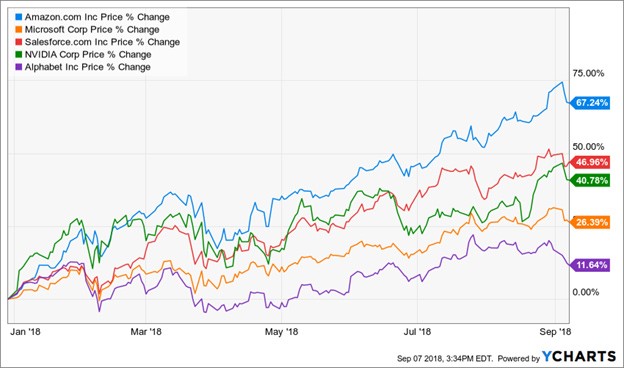Amazon.com (AMZN), Microsoft (MSFT), Alphabet (GOOG), Salesforce.com (CRM) and Nvidia (NVDA) are building large AI footprints. They own infrastructure, platforms and the cutting-edge technology that’s advancing, says Jon Markman, who's presenting at MoneyShow Dallas Oct. 3-4.
Artificial intelligence is going to be big. The evidence is everywhere. Yet, many investors underestimate the impact. Others dismiss the technology as hype. But a provocative story last week from Quartz should change even the most-ardent skeptic’s mind.
AI algorithms are identifying cancers, limiting test false positives, and freeing up doctors for value-added services.
The technology is a game-changer for corporate profits.
AI is frequently misunderstood. We humans often can’t get past the idea that machines will make us all obsolete.
Blame science fiction, and our innate fear of redundancy. However, machines are better at repetitive tasks like analyzing vast amounts of information quickly.
In the digital era, there is more data than ever. Harnessing that skillset benefits humans.
To test this thesis, Quartz enlisted the help of Leon Chen, the cofounder of MD.ai, a medical AI startup, and Luke Oakden-Rayner, a radiologist.
They showed their algorithms some 190,332 images of malignant, benign and tumor-free CAT scans.
These algorithms were trained to detect tumors, then gauge their malignancy.
The results were stunning …
After 20 minutes and 50,000 images processed, the system started to learn relatively simple concepts. In less than two hours, the algorithms began to recognize tumors and likely malignancies — and they did so at the same rate as humans.
The medical technology industry is rife with similar findings.
A team of researchers led by Holger Haenssle, a professor at Germany’s University of Heidelberg, pitted an AI system against 58 dermatologists.
Human doctors detected 86.6% of skin cancers. The algorithmic system discovered 95%, with fewer false positives.
Verily and Deep Mind, both units of Alphabet (GOOGL), are using AI and a picture of the patient’s eyes to assess their risk of heart disease. The software was developed by training algorithms to look for hidden patterns in the medical data of 300,000 patients.
The utility of AI is efficiently spotting needles in haystacks.
In the healthcare sector, finding solutions quickly and cost-effectively is valuable. The U.S. spent $3.3 trillion on healthcare in 2016, or 17.8% of GDP. This percentage is the highest in the developed world. Spending for physician and clinical services grew to $664.9 billion, up 5.4% over 2015, and remains the fastest-growing portion of overall annual spend.
Something has to give.
The use of AI has the potential to radically change the way care is administered.
An effective, algorithmic first screen for disease would free up doctors to see more patients in other value-added capacities. It would bring quicker diagnosis to underserved remote locations. It would slash costs by eliminating many expensive follow-up tests.
And healthcare is only one application. AI is permeating every part of the economy.
• A paucity of false positives will make research-intensive businesses less costly.
• Energy companies will drill fewer dry wells.
• Big pharma will have greater certainty.
• The days of hit-and-miss drug discovery will come to an end.
• Retailers will also be big winners.
And by mining vast amounts of data, even outliers like weather, and managing inventories and supply chains, will get easier.
Many investors are missing this massive opportunity. They can’t see the positive implications for corporate profitability. They are too insecure about jobs or the idea that the technology is being overhyped.

Five of our favorite AI stocks are up 11.6% to 67.3% year-to-date.
In April 2018, the McKinsey Global Institute released an exhaustive research paper about AI trends. The analysts estimate AI has the potential to create $3.5 trillion to $5.8 trillion in value annually across 19 industries.
Although the bulk of this is expected to come from marketing, sales and supply chain management, there will be ancillary benefits, too.
For example, a European trucking company used AI to optimize routing. The company reduced fuel costs by 15%, while improving delivery times.
They will grab a big part of future AI spend. Longer-term investors should recognize the macro trend and use significant weakness to take positions.
Investors also should not worry about widespread human redundancy. AI learning systems are still black boxes. They work well on a narrow range of tasks. At this juncture, they are tools, not replacements.
Best wishes,
Jon D. Markman
P.S. AI isn’t the technology of the future — it’s already saving companies big money and making them far more. As companies perfect, use and sell what they’ve learned, their share prices will follow. To get in on the best stocks in this massive megatrend, consider taking my Tech Trend Trader for a test-drive today. Click here to make this smart move today.
Subscribe to Jon Markman’s Power Elite newsletter here
Subscribe to Jon Markman’s Tech Trend Trader here
Subscribe to Jon Markman’s Strategic Advantage here
I’ll be speaking at the Money Show Dallas Oct. 3-4. It will be a great show, with all sorts of experts sharing their insights. You can find more about that incredible conference by clicking here. I hope to see you there!
View Jon Markman's 5 tech stock picks in a short video.
Recorded: August 24, 2018.
Duration: 5:13.





















